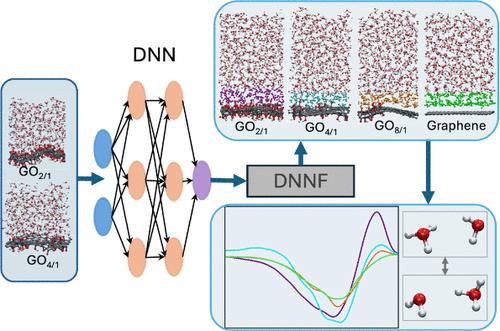当前位置:
X-MOL 学术
›
J. Phys. Chem. C
›
论文详情
Our official English website, www.x-mol.net, welcomes your
feedback! (Note: you will need to create a separate account there.)
From Graphene Oxide to Graphene: Changes in Interfacial Water Structure and Reactivity Using Deep Neural Network Force Fields
The Journal of Physical Chemistry C ( IF 3.3 ) Pub Date : 2024-09-24 , DOI: 10.1021/acs.jpcc.4c03444 Golam Azom, Anne Milet, Rolf David, Revati Kumar
The Journal of Physical Chemistry C ( IF 3.3 ) Pub Date : 2024-09-24 , DOI: 10.1021/acs.jpcc.4c03444 Golam Azom, Anne Milet, Rolf David, Revati Kumar

|
Graphene oxides (GO) are thin graphene sheets containing oxygen-bearing defects. These sheets have a complex structure with sp3 carbons interspersed among sp2 carbons, which results in competition between aromatic and hydrophilic domains at the GO–water interface. The GO–water as well as neat graphene–water interfacial regions play a crucial role in various applications. While ab initio molecular dynamics simulations provide high accuracy in studying this complex region, they require significant computational resources, which limits the investigation of the interface at both time and length scales. To tackle this issue, a deep neural network force field (DNNF), trained and validated on AIMD data, was developed. It achieves DFT-level accuracy using only a fraction of the computational cost. This DNNF has been successfully used for simulating graphene oxide to reduced graphene oxide right up to fully reduced graphene–water interfaces. The ordering of water near the interface was studied as a function of oxidation level from fully oxidized graphene oxide to graphene. The vibrational sum frequency generation spectrum of the graphene–water interface was determined and compared to experimental data as well as spectra from graphene oxide–water sheets at different oxidation levels. Connections between different spectral signatures and the orientation of different waters were determined. The reactivity and buckling of the different sheets were examined. The analyses of the trajectories revealed the formation of multiple hydronium formation events with sustained proton hopping over more than a 100 ps in the fully oxidized GO–water systems.
中文翻译:

从氧化石墨烯到石墨烯:利用深层神经网络力场改变界面水结构和反应性
氧化石墨烯(GO)是含有含氧缺陷的薄石墨烯片。这些片层具有复杂的结构,其中sp 3碳散布在sp 2碳之间,这导致GO-水界面处芳香域和亲水域之间的竞争。 GO-水以及整齐的石墨烯-水界面区域在各种应用中发挥着至关重要的作用。虽然从头算分子动力学模拟在研究这个复杂区域时提供了高精度,但它们需要大量的计算资源,这限制了在时间和长度尺度上界面的研究。为了解决这个问题,开发了一种基于 AIMD 数据进行训练和验证的深度神经网络力场 (DNNF)。它仅使用一小部分计算成本即可实现 DFT 级别的精度。该 DNNF 已成功用于模拟氧化石墨烯到还原氧化石墨烯直至完全还原的石墨烯-水界面。研究了界面附近水的排序与从完全氧化的氧化石墨烯到石墨烯的氧化水平的函数。确定了石墨烯-水界面的振动和频率生成谱,并将其与实验数据以及不同氧化水平下氧化石墨烯-水层的谱进行比较。确定了不同光谱特征和不同水的方向之间的联系。检查了不同片材的反应性和屈曲。轨迹分析揭示了在完全氧化的 GO-水系统中,多个水合氢形成事件的形成,质子持续跳跃超过 100 ps。
更新日期:2024-09-25
中文翻译:

从氧化石墨烯到石墨烯:利用深层神经网络力场改变界面水结构和反应性
氧化石墨烯(GO)是含有含氧缺陷的薄石墨烯片。这些片层具有复杂的结构,其中sp 3碳散布在sp 2碳之间,这导致GO-水界面处芳香域和亲水域之间的竞争。 GO-水以及整齐的石墨烯-水界面区域在各种应用中发挥着至关重要的作用。虽然从头算分子动力学模拟在研究这个复杂区域时提供了高精度,但它们需要大量的计算资源,这限制了在时间和长度尺度上界面的研究。为了解决这个问题,开发了一种基于 AIMD 数据进行训练和验证的深度神经网络力场 (DNNF)。它仅使用一小部分计算成本即可实现 DFT 级别的精度。该 DNNF 已成功用于模拟氧化石墨烯到还原氧化石墨烯直至完全还原的石墨烯-水界面。研究了界面附近水的排序与从完全氧化的氧化石墨烯到石墨烯的氧化水平的函数。确定了石墨烯-水界面的振动和频率生成谱,并将其与实验数据以及不同氧化水平下氧化石墨烯-水层的谱进行比较。确定了不同光谱特征和不同水的方向之间的联系。检查了不同片材的反应性和屈曲。轨迹分析揭示了在完全氧化的 GO-水系统中,多个水合氢形成事件的形成,质子持续跳跃超过 100 ps。











































 京公网安备 11010802027423号
京公网安备 11010802027423号